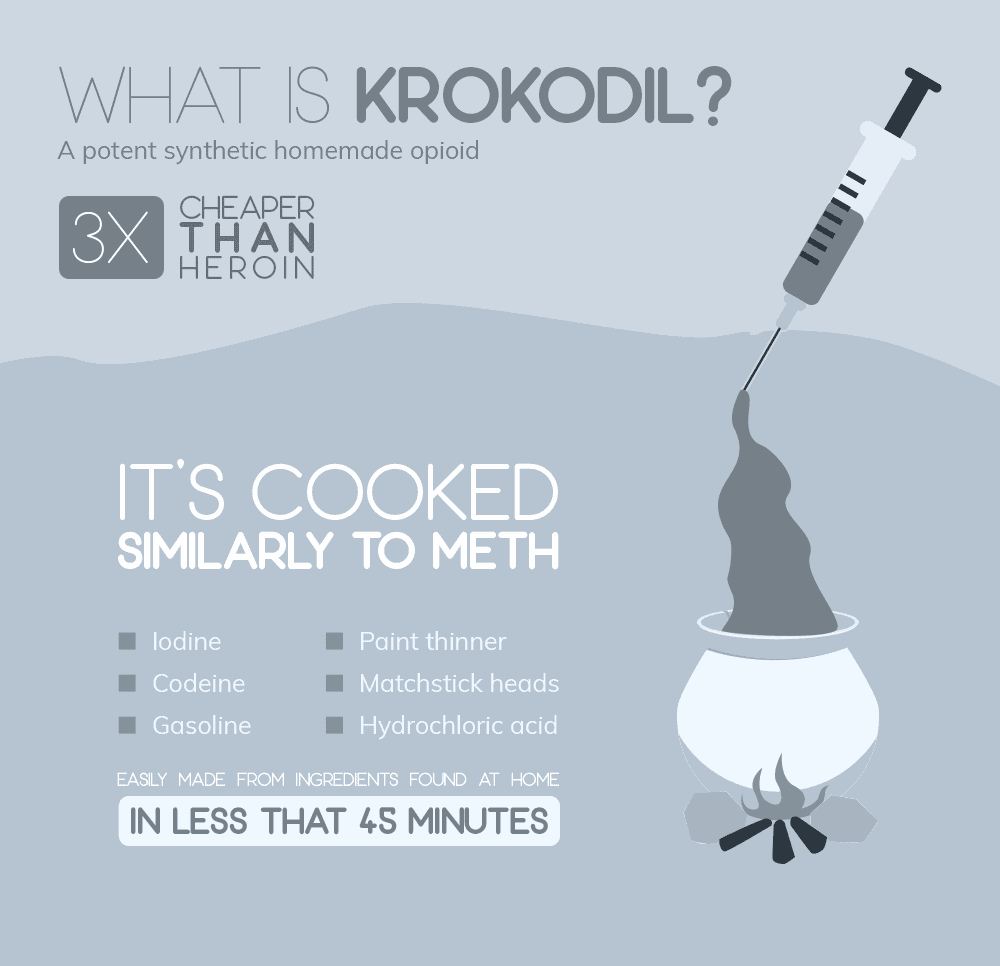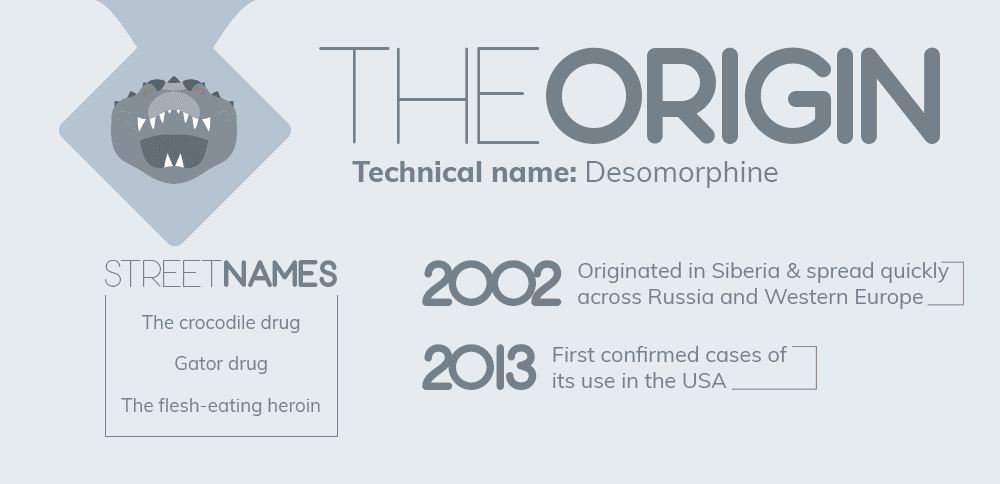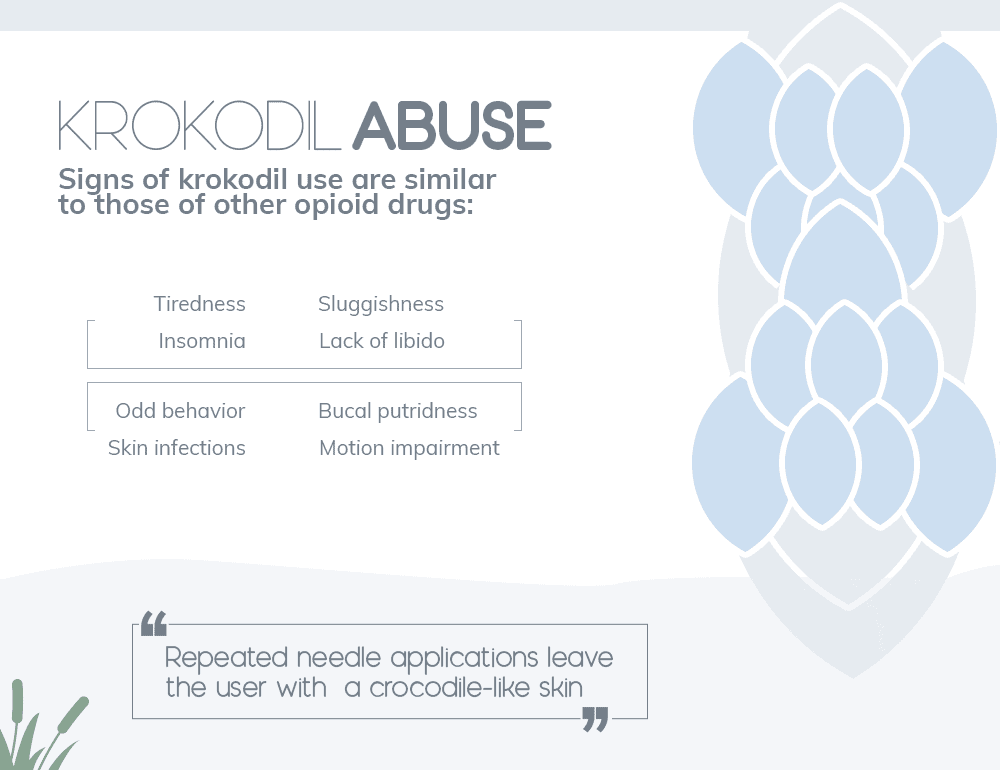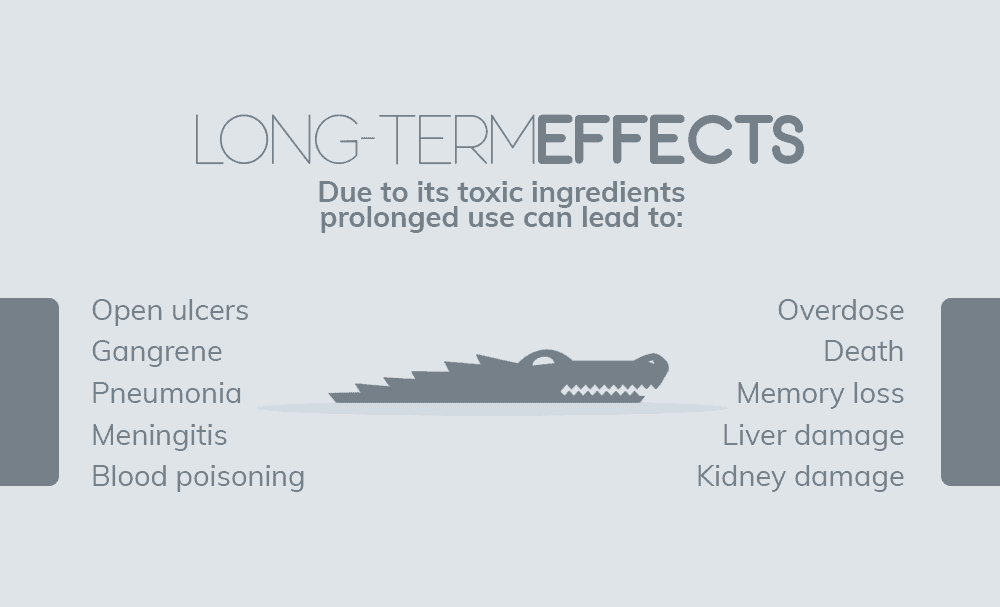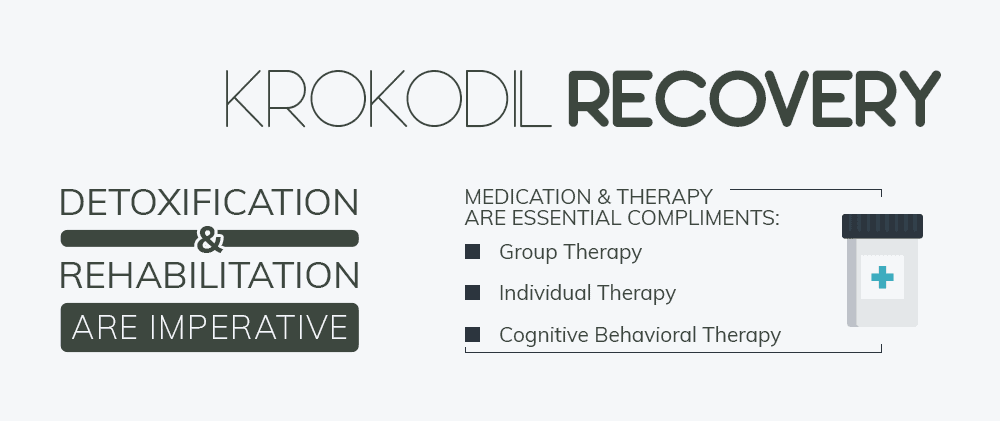Krokodil pops up in United States just as it’s experiencing an opioid epidemic. These drugs come in many forms – both illicit and prescribed. There are many reasons for its rise in use, but healthcare professionals agree that one factor stands out as crucial: the increase in prescribed opioids. In a snowballing course of events, many Americans prescribed opioids for pain management become addicted to the pills. When they are unable to obtain more via prescription, they begin seeking illicit means of procuring drugs. Many users find themselves using heroin because it’s more cheaply obtained. The use of opioids such as morphine, heroin, and prescription pain medications is becoming a serious global problem affecting an estimated 26.4 to 36 million people. In the United States, an estimated 2.1 million Americans are suffering from substance abuse disorders related to opioids. Of those 2.1 million, 467,000 are addicted to heroin.
“Get help from our 28-Day Drug Rehab Program – Designed to help you avoid relapses and maintain long-term sobriety”
According to the 2014 Senate Caucus on International Narcotics Control, “This greater availability of opioid (and other) prescribed drugs has been accompanied by alarming increases in the negative consequences related to their abuse. For example, the estimated number of emergency department visits involving nonmedical use of opioid analgesics increased from 144,600 in 2004 to 305,900 in 2008; treatment admissions for primary abuse of opiates other than heroin increased from one percent of all admissions in 1997 to five percent in 2007; and overdose deaths due to prescription opioid pain relievers have more than tripled in the past 20 years, escalating to 16,651 deaths in the United States in 2010.”
So what’s Krokodil and where does it fit into the larger opioid issue?
Krokodil is also known as desomorphine. It’s a derivative or morphine with extremely powerful, quick-acting effects. Like other opioids, it’s main effects are sedation and pain relief. This opioid differs from heroin and other opioid street drugs in that it is “cooked” in a process similar to methamphetamine production. Like heroin use, Krokodil’s use seems to be prompted by the uptick in pain medication prescriptions. It’s recent use isn’t quite as popular in the U.S., however. There is concern that this frightening new drug will gain popularity in America. For now, it’s manufacture and use seems heavily concentrated in Russia.
Krokodil’s Hold On Russian Addicts
Although Krokodil, or desomorphine, was first synthesized in Switzerland in 1932, it has become an increasingly used drug in Russia. According to Time Magazine, “Krokodil, a cheap substitute for heroin, was one of the deadliest designer drugs ever to sweep through Russia. Appearing on the black market in the early 2000s, it wound up ensnaring hundreds of thousands of addicts across the country, and it spread especially fast in poor, industrial areas like Uralmash, [Russia]. Its appeal was simple: addicts could easily learn to cook it in their kitchens using ingredients purchased at local pharmacies and hardware stores, among them hydrochloric acid, paint thinner and red phosphorous, which they scraped from the sides of match boxes. For a fraction of the price of heroin, the drug produced a similar high and was just as addictive.” It seems to have come out around 2002 in rural Russia. The name of the drug got its name from the fact that users often develop crocodile-like scaling skin.
What Are the Signs of Someone Using Krokodil?
If you suspect someone is addicted to any opioid, including Krokodil, here are some of the common symptoms of abuse:
- They are tired all the time. They may start falling asleep at the dinner table, in the middle of a conversation or while watching TV.
- Changes in their sleep pattern. They may be sleeping for 18 hours straight or not sleeping for days depending on if they are using the drug.
- They may no longer be interested in sex. Opioids decrease testosterone and estrogen levels in the body.
- Losing their friends. Are they hanging out with different people? Do old friends seem to have disappeared?
- Stealing money or items. They may be stealing or selling items to get money to buy more drugs.
- They are spending more money than ever before. If credit card envelopes are being delivered more often or creditors are calling, there may be a problem.
Krokodil, like symptoms of methamphetamine, has physical effects as well. Those who take this kind of opioid may have skin lesions and other obvious infections.
The Long-term Effects of Using Krokodil
Due to the homemade production of Krokodil, toxins can make their way into the drugs. Besides the traditional signs and symptoms of opioid use, Krokodil can also cause long-term health issues that include:
- Blood vessel infections
- Open ulcers
- Gangrene
- Skin infections
- Soft tissue infections
- Skin grafts
- Limb amputations
- Pneumonia
- Blood poisoning
- Meningitis
- Rotting gums
- Tooth loss
- Blood-borne virus transmission (HIV, Hepatitis)
- Bone infections
- Speech impairment
- Fine and gross motor impairment
- Memory loss
- Difficulty focusing
- Damage to liver and kidneys
- Overdose
- Death
The estimated lifespan of a Krokodil user is about two years. Compare this to the lifespan of a heroin addict, which could be anywhere from 15 years to weeks. Krokodil is just far too addictive and toxic to allow users to survive longer. Like heroin, the drug is incredibly addictive even for new users. The body becomes tolerant extremely quickly, resulting in the need for higher and higher doses.
The Toxic Concerns of Krokodil to Opioid Addicts
Due to its illicit production, often in the homes of users, it’s often impure and contains large amounts of toxic chemicals. This is a result of it being “cooked” and unfiltered or distilled to release toxins. Addicts injecting the drug suffer damage to skin, blood vessels, muscles and bones. Long-term users have been known to require amputations due to advanced infections within a limb. The drug contains iodine and phosphorus among other toxic substances. Krokodil got its name from the tissue damage many of its users have. The drug has been called a “flesh-eating drug” and “zombie drug” due to the necrotic ulcerations that appear at injection sites. In its pure form, desomorphine does not cause side effects like these, so it’s safe to assume these dangerous skin issues have to do with the drug’s manufacture.
Cases of Krokodil Use in the United States
According to the American Society of Addiction Medicine (ASAM), “Drug overdose is the leading cause of accidental death in the US, with 52,404 lethal drug overdoses in 2015. Opioid addiction is driving this epidemic, with 20,101 overdose deaths related to prescription pain relievers, and 12,990 overdose deaths related to heroin in 2015.” But does Krokodil effect these numbers? Although some news has surfaced regarding a “flesh-eating drug” called Krokodil in the United States. For the most part, however, the evidence is not there to support a nationwide health scare beyond the current heroin epidemic. The Chicago Tribune reported, “The drug reportedly cropped up in Russia and Ukraine, where codeine is available over the counter and heroin is difficult to get. But Chicago-area public health officials and experts who deal almost daily with heroin addicts voiced skepticism that Krokodil has arrived in the region, or that it is likely to become widespread.” The same sort of sentiment was reported by NBC in Louisville, “A drug with a terrifying reputation for rotting the flesh of users is making its way across the country. Now, the Russian heroin knock off called Krokodil is in Kentuckiana, at least that’s what is making headlines. Those reports, may be premature. While the drug itself, and the horrific effect it has on the body, are real aspects of Krokodil’s United States invasion appear to be a myth – one that spread from the internet to network television.” By why hasn’t America been keen to try this new, more addictive drug? Forbes says, “In U.S. cities, heroin, methamphetamine and prescription drugs are the reigning addiction heavyweights. It’s unlikely that krokodil will ever come close to any of these, or for that matter even take hold here. The relatively lower cost and higher availability of other drugs makes using a corrosive, euphoric acid unappealing to even the worst-off junkies. As a Slate article recently pointed out, why would drug users in the U.S., where heroin is relatively cheap and easy to find, go out of their way to find krokodil, a drug that would be much harder to locate and will eat their flesh?”
What Healthcare and Law Enforcement Officials Are Doing About Krokodil
In the U.S., there isn’t much being done regarding Krokodil specifically. It’s doesn’t fall under the typical model of drug smuggling and distribution since it’s created at home using common, over-the-counter (OTC) medications. There are, however, laws nationwide protecting and limiting the sale of OTC medications containing codeine. Heroin and prescription painkillers continue to be the top priorities for law enforcement officials.
Does Traditional Rehab and Detox Work for Krokodil Addicts?
Short answer: absolutely. Opioid addiction detox and rehabilitation, in conjunction with ongoing therapies are vital. Every part of the body and mind need to be supported through this time. Also, depending on co-occurring disorders that may be taking place, different therapies can be useful. At Northpoint Washington, we have a wide variety of treatment options for our patients. Cognitive Behavioral Therapy (CBT) – Focuses on breaking dysfunctional thought patterns and actions. This is an effective approach for those with co-occurring mood disorders such as anxiety. The goal is to transform dysfunctional thoughts into positive ones. It also tries to find effective, personal stress coping skills that aren’t substance abuse. Group Therapy – Group therapy can be personalized for people suffering from a specific dual diagnosis. Group therapy begins with members being educated on their diagnosis. Groups are encouraged to work together in order to motivate each other. The goal is to foster relationships as well as increase the sense of self-worth and optimism that comes from members working through a common challenge.. Individual Therapy– Individual therapy is also known as talk therapy or counseling. The general goal is to increase the patient’s overall well-being. Therapy is a safe place to discuss trauma and difficulties in the recovery. Topics of discussion are not limited to addiction or a dual diagnosis. In fact, patients will be encouraged to discuss past triggers in order to work through them. Counselors will also help with raising self-esteem, courage, and kindness as tools for rehabilitation. Medications – Abusing substances is never a good way to cope with stress or mental illness, but treating a dual diagnosis with doctor prescribed medications can benefit some people in recovery. For example, those with mood disorders may be prescribed antidepressants, anxiolytics and antipsychotics. Or they could be prescribed drugs such as selective serotonin reuptake inhibitors (SSRIs). These drugs include Prozac and Zoloft. SSRIs can regulate chemical imbalances by increasing serotonin levels. Due to their mild side effects, SSRIs are more commonly used to treat mood disorder. Learn more about our facility’s rehabilitation offerings here. There is always hope for a better life. Don’t wait until it’s too late to make a positive change.
What Did you Think About This Blog?
Give it a Rating!


